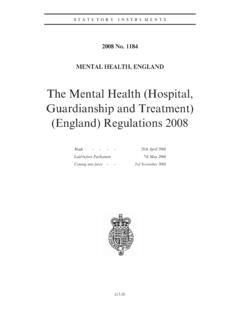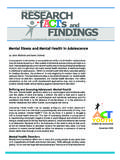Transcription of The treatment gap in mental health care - WHO
1 858 Bulletin of the world health organization | November 2004, 82 (11)Abstract mental disorders are highly prevalent and cause considerable suffering and disease burden. To compound this public health problem, many individuals with psychiatric disorders remain untreated although effective treatments exist. We examine the extent of this treatment gap. We reviewed community-based psychiatric epidemiology studies that used standardized diagnostic instruments and included data on the percentage of individuals receiving care for schizophrenia and other non-affective psychotic disorders, major depression, dysthymia, bipolar disorder, generalized anxiety disorder (GAD), panic disorder, obsessive compulsive disorder (OCD), and alcohol abuse or dependence. The median rates of untreated cases of these disorders were calculated across the studies.
2 Examples of the estimation of the treatment gap for WHO regions are also presented. Thirty-seven studies had information on service utilization. The median treatment gap for schizophrenia, including other non-affective psychosis, was For other disorders the gap was: depression, ; dysthymia, ; bipolar disorder, ; panic disorder, ; GAD, ; and OCD, Alcohol abuse and dependence had the widest treatment gap at The treatment gap for mental disorders is universally large, though it varies across regions. It is likely that the gap reported here is an underestimate due to the unavailability of community-based data from developing countries where services are scarcer. To address this major public health challenge, WHO has adopted in 2002 a global action programme that has been endorsed by the Member mental health services/utilization; health services accessibility; Schizophrenia/therapy; Anxiety disorders/therapy; Mood disorders/therapy; Compulsive personality disorder/therapy; Alcoholism/therapy; Epidemiologic studies; Cost of illness; Americas; Europe (source: MeSH, NLM).
3 Mots cl s Service sant mentale/utilisation; Accessibilit service sant ; Schizophr nie/th rapeutique; Etat anxi t /th rapeutique; Troubles humeur/th rapeutique; Personnalit compulsive/th rapeutique; Alcoolisme/th rapeutique; Etude analytique (Epid miologie); Co t maladie; Am rique; Europe (source: MeSH, INSERM).Palabras clave Servicios de salud mental /utilizaci n; Accesibilidad a los servicios de salud; Esquizofrenia/terapia; Trastornos de ansiedad/terapia; Trastornos del humor/terapia; Trastorno de personalidad compulsiva/terapia; Alcoholismo/terapia; Estudios epidemiol gicos; Costo de la enfermedad; Americas; Europa (fuente: DeCS, BIREME).Bulletin of the world health organization 2004;82 page 864 le r sum en fran ais. En la p gina 864 figura un resumen en espa treatment gap in mental health careRobert Kohn,1 Shekhar Saxena,2 Itzhak Levav,3 & Benedetto Saraceno21 Brown University Department of Psychiatry and Human Behavior, Providence, RI, USA.
4 Correspondence should be sent to Dr Kohn at Butler Hospital, 345 Blackstone Blvd, Providence, RI, USA, (email: world health organization , Department of mental health and Substance Dependence, Geneva, Ministry of health , Jerusalem, No. 03-005736(Submitted: 22 June 2003 Final revised version received: 20 November 2003 Accepted: 21 November 2003)IntroductionThe care of people with mental and brain disorders is a grow-ing public health concern. These disorders are highly prevalent and exact a high emotional toll on individuals, families, and society. Worldwide, community-based epidemiological studies have estimated rates of lifetime prevalence of mental disorders among adults ranging from to and 12-month prevalence rates ranging from to (1). These rates do not include neurological conditions affecting the brain (1).)
5 WHO (2) has estimated that approximately 450 million individuals worldwide suffer from neuropsychiatric disorders in their disorders are not only highly prevalent medical conditions but they are also highly disabling. Measured by years lived with disability and by premature death in disability- adjusted life years (DALYs), psychiatric and neurological condi-tions accounted for over 13% of the global disease burden in the year 2001 (3). When compared with 1990, the contribution of neuropsychiatric disorders is expected to increase to almost 15% by the year 2020 (4). Among individuals age 15 44, unipolar depression is the second leading contributor of DALYs, with alcohol-related disorders, schizophrenia, and bipolar disorder among the top 10 disorders. Approximately 33% of all years lived with disability (YLD) are imputed to neuropsychiatric conditions.
6 Of the 10 leading causes of YLD in the world among individuals of all ages, four are psychiatric conditions, with unipolar depression being the leading cause (2). Among individuals between the ages of 15 and 44, panic disorder, drug use disorders, and obsessive compulsive disorder (OCD) were included in the top 20 of the world health organization | November 2004, 82 (11) Policy and Practice Robert Kohn et al. The treatment gap in mental health care the analysis to overall utilization. The treatment gap from each of the available studies was determined for each specific median and average rates of service utilization across the studies were calculated for each disorder. Using the median rate prevents outliers from having an undue influence. Adequate data were not available for all WHO regions, but examples of regional treatment gap rates were calculated.
7 Regional treatment gap (G) calculations take into account the service utilization rate (Sc), the prevalence rate (Rc), and the population size (Pc) of each of the countries:We estimated the population in each country of indi-viduals age 15 and older. The latest census data by age distri-bution were obtained from the United Nations demographic yearbook (13). Since the last census year varied from country to country, the estimates prepared by WHO for the year 1999 were used (14). These estimates provided data only on an individual Member country s total population. To estimate the propor-tion of individuals aged 15 and older, data from the last census was applied to the 1999 total population estimate to obtain an approximation of each country s population as well as of regional description of the 37 studies with data on service utilization is included in Appendix 1.
8 The references are available in Appen-dix 2 (Appendix 1 and Appendix 2, web version only, available at: ). The treatment gap is shown as percentage and the median and average treatment gap for each disorder is shown in Table 1. Where available, the rates of use of specialized mental health services are median untreated rate, or treatment gap, for schizo-phrenia including other non-affective psychoses was For other disorders the gap was: major depression, ; dysthymia, ; bipolar disorder, ; panic disorder, ; GAD, ; and OCD, Alcohol abuse and dependence had the largest treatment gap at The treat-ment gap varied widely between countries. As an illustration, for schizophrenia the gap among young adult Jews in Israel was only , while the rate in New Zealand in a population of 21-year-olds was The treatment gap in Italy was for major depression, while studies in the United Kingdom gave an estimate of The treatment gap for alcohol abuse and dependence was high across all studies: Jewish-Israeli young adults had the lowest gap ( ) but in Mexico City among the general adult population few were in treatment ( ).
9 Service-related information from psychiatric epidemio-logical studies for many regions of the world was not available, so regional estimates of the treatment gap were not possible. As a result, examples of the treatment gap for major depression are presented for the Americas and the European Regions of WHO, since there is a good representation of studies across the countries in these two regions. The 12-month prevalence, or if not available, the current prevalence, were applied. When more than one study was available for a country, the most representative ones were used (those that referred to the entire sample studied). For the United States, the Epidemiological Catchment Area (ECA) and National Comorbidity Survey (NCS) prevalence and service utilization rates were averaged, as In part, the excess disability due to mental disorders is a result of their early age of onset (1).
10 The magnitude of this bur-den also results from the fact that only a minority of individuals with these disorders ever receive treatment in the specialized mental health care system or in the general health care system (5); initial treatment is frequently delayed for many years (6). Numerous reasons have been imputed. These include: failing to seek help because the problem is not acknowledged, perceiving that treatment is not effective, believing that the problem will go away by itself, and desiring to deal with the problem without outside help (7, 8). In addition a lack of knowledge about mental disorders and stigma remain major barriers to care (9, 10). Factors that are direct barriers to care also preclude treatment , including financial considerations (11), issues of accessibility, as well as limited availability or lack of availability of services in many countries or for some populations (12).
















